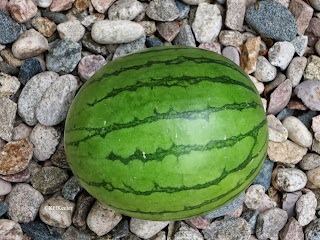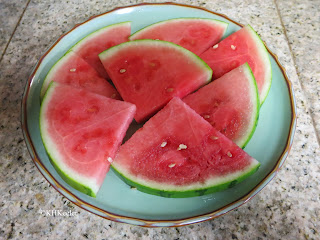 |
| watermelon, xigua |
So it was a surprise that In China, not just in American Chinese restaurants, watermelon is the usual dessert. The meal ends when slices of watermelon are served.
It is a long way from Denver to Shanghai. Where is watermelon from?
Since wild watermelons (Citrullus lanatus, in the cucumber family, Cucurbitaceae) can readily be found in the deserts and semideserts of southern Africa, that is believed to be where the plant first encountered people. Domestication of watermelons probably occurred in south or central Africa, but there is little record of it. What is known is that recognizable watermelons were portrayed in Egyptian paintings from as early as 3100-2180 BC and seeds were found in the tomb of King Tutankhamun (ca. 1330 BC). Thereafter watermelons can periodically be found in murals and mosaics at locations around the Mediterranean from the Roman era (510 BC to about 410 AD) and in southern European medieval herbals (AD 1200-1500). (see a medieval European picture ).
Not all of the watermelons of premodern Europe were our familiar sweet red-fleshed watermelon. Although there are reportedly wild watermelons that are sweet, the majority of the wild watermelons are pretty bitter. They are edible if cooked or pickled. Many cultures have and continue to use bitter watermelon seeds roasted and for oil. Bitter watermelons tend to be round, not oval, with white flesh. Botanically, the bitter, round, white-fleshed melons are watermelons, Citrullus lanatus, but they are popularly called citrons, citron melons or preserving melons.
Complicating this picture, the name citron is shared between the bitter watermelon and a citrus fruit, the citron, Citrus medica. The citrus citron is a tree that produces a round fruit that looks a lot like a grapefruit, Citrus x paradisi. Citrus medica is a much older plant than the grapefruit. Citrons were domesticated prehistorically in Asia and reached Persia by 300 BC. Grapefruits are derived from a mutant of the pomelo, Citrus maxima, that occurred about 1750 in Barbados (More on grapefruit). Citrons are too bitter to eat fresh, so are mainly pickled. (More on citrons). One citron grows on a vine, the other on a tree, you wouldn't mix them up if the plant was present.
 |
| sweet watermelon, not citron |
As late as the 1400s in Europe, many of the watermelons were citron melons, not sweet watermelons. In about half of the 14th-16th century southern European manuscripts studied by H. S. Paris and collaborators, the watermelon shown is the citron melon.
Today citron melons are rarely cultivated or sold. They have, however, naturalized in the southern U.S. where they can be found in waste places and as a crop weed. (U. Florida weeds , eattheweeds ).
Watermelons are first recorded in China in the 10th century. The Chinese name is xigua, "western fruit," reflecting the idea that it is not native. But it has been there for 1000 years now. As in the West, watermelon is very popular. Older reports describe diverse colors and sizes of watermelons in China but today the familiar big red-fruited ones dominate. The Chinese love watermelon seeds as well as fresh watermelon. China produces the most watermelon in the world: Chinese watermelon production in 2010 was six times the production of the next four countries combined! (See the numbers).
Watermelons were brought to the Americas soon after settlement. The earliest record is from Spanish Florida in 1576. By the 1600s watermelons can be documented all over North, Central and South America--wherever the growing season is long enough.
Between citron melons and sweet watermelons, there were and are many interesting varieties of watermelon that are small to large, round to oval, with rinds from pale almost yellow to deep green, with or without stripes, with flesh that is white, yellow, orange or red and with seeds in colors from white to black. The taste tells you that it is a watermelon and not some other kind of melon, not the appearance. See some of the variety at Rare Seeds.
The watermelon of my picnic and of the meal in Shanghai are both immigrants, originating long ago from the same source, and carried across the world by their fans.Comments and corrections welcome.
References
Bates, D. M. and R. W. Robertson. 1995. Cucumbers, melons and water-melons. Pp. 89-96 IN: J. Smartt and N. W. Simmonds. Evolution of Crop Plants. 2nd ed. Longman Scientific and Technical, London.
Kiple, K. F. and K. C. Ornelas, editors. 2000. Cucumbers The Cambridge world history of food.Cambridge University Press, Cambridge.online: http://www.cambridge.org/us/books/kiple/cucumbers.htm
Needham, J. 1986. Science and civilization in China. Vol VI:1 Botany. Cambridge University Press, Cambridge.
Paris, H. S., M-C. Daunay and J. Janick. 2013. Medieval iconography of watermelons in Mediterranean Europe. Annals of Botany. 112 : 867-879.
Valder, P. 1999. The Garden Plants of China. Timber Press, Portland OR
Valder, P. 1999. The Garden Plants of China. Timber Press, Portland OR
Links updated 1/30/21.


Thank God we have some informative blogs now, fruits like watermelon have healthy stuff for our kids and such initiatives are beneficial for kids in order to learn more about importance of fruits..
ReplyDelete